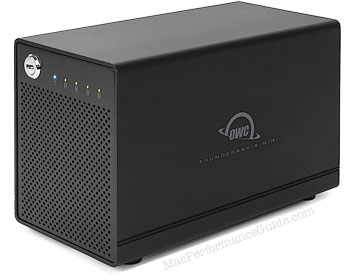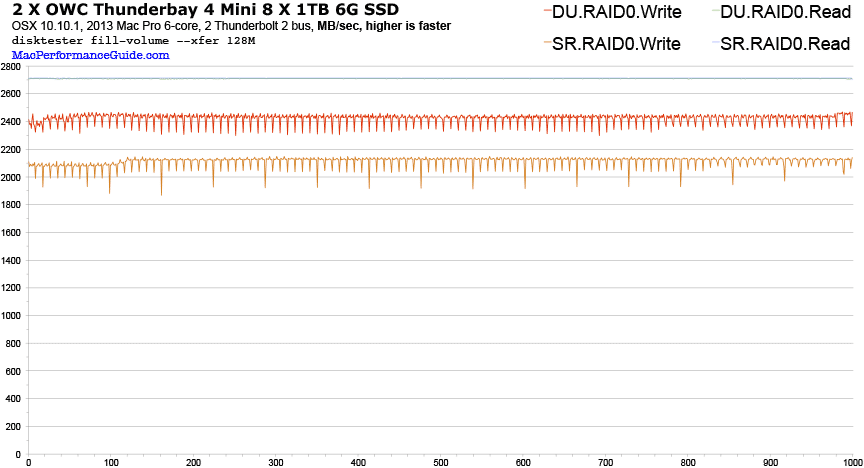
|

|

|

|

|

$220 SAVE $130 = 37.0% Western Digital 16.0TB Western Digital Ultrastar DC HC550 3.5-in… in Storage: Hard Drives
|

|

|

|

|
Outrageous Speed with 8 SSDs in Dual Thunderbay 4 Minis
Related: 2013 Mac Pro, Mac Pro, Other World Computing, OWC Thunderbay, RAID, RAID-0, RAID-1, RAID-4, RAID-5, SoftRAID, SSD, storage, Thunderbolt, video, weather events

Dual OWC Thunderbay 4 Mini units each with four OWC 960 GB Mercury Electra 6G SSDs were used for these tests.
Each Thunderbay 4 Mini was connected to a separate bus on the Mac Pro, thus allowing full performance to be delivered to each Thunderbay 4 Mini.
What kind of performance is possible when if dual OWC Thunderbay 4 Mini units are connected on two Thunderbolt 2 busses on a Mac Pro?
Outrageously fast performance.
RAID-0 stripe
disktester fill-volume --xfer 128M
Writes the entire capacity (8TB) as 1000 large files, then reads back those 1000 files, using the OS X file system for real-world throughput through the OS X file system. Data graphed using the supplied graph spreadsheets in diglloydTools.
This tests shows the maximum possible speed from the 8 SSDs in the two Thunderbay 4 units using large transfers sizes. Both Disk Utility and SoftRAID 5.0.5 were tested and seen to offer equal speed for reads, but Disk Utility is faster for writes (SoftRAID team is now investigating why writes are slower with SoftRAID).
Write: 2424 MB/sec (Disk Utility)
Read: 2708 MB/sec (Disk Utility)
Look at the read-speed flat-line consistency! WOW.
MPG has never before seen such high I/O speeds. Adding a 3rd Thunderbay 4 unit on the 3rd Mac Pro Thunderbolt 2 bus could be expected to deliver about 3600 MB/sec (3.6 gigabytes per second). Certain very high end video applications can use this kind of speed.

RAID-4 / RAID-5 (fault tolerant)
disktester fill-volume --xfer 128M
RAID-4 (dedicated parity drive) and RAID-5 (distributed parity) are the same in function.
RAID-4 and RAID-5 suffer on write speed, but read speed is super, inline with RAID-0 striping (7 drives striped essentially, instead of 8 with RAID-0).
Write: 1446 MB/sec (Disk Utility)
Read: 2375 MB/sec (Disk Utility)
Look at the read-speed flat-line consistency! WOW. Write performance is close to flat-lined also. Superb.
The fault tolerance of RAID-4 / RAID-5 make a lot of sense in an 8-drive setup if the system has to stay up and working even if one drive fails. The lower write speed is simply not an issue for most applications (rare indeed).

RAID-5 (fault tolerant) vs RAID-1+1 (more fault tolerant)
disktester fill-volume --xfer 128M
Both RAID-5 and RAID-10 have some kind of bottlneck on writes which limits speed roughly to the theoretical maximum for a single Thunderbolt bus.
RAID-5 write/read: 1423 / 2369 MB/sec (SoftRAID)
RAID-1+0 write/read: 1046 / 1560 MB/sec (SoftRAID)
Look at the read-speed flat-line consistency! WOW. Write performance is close to flat-lined also. Superb.
The fault tolerance of RAID-1+0 cuts storage capacity in half (striped pair of mirrors), but might make sense for some high-value data capture uses, where the delay for backup takes more than an acceptable time.

Seagate 22TB IronWolf Pro 7200 rpm SATA III 3.5" Internal NAS HDD (CMR)
SAVE $100

 diglloydTools™
diglloydTools™

